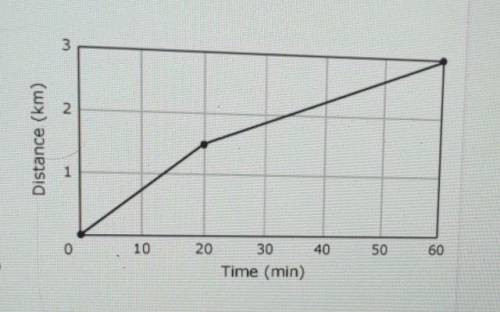
Physics, 12.02.2021 22:20 hannahbaak
PLEASE HELP I CANT FAIL. PLEASE. THANK YOU. The graph to the right shows distance over time. Which of these situations could be represented by this graph?
A) Distance (km) A A student walks 1.5 km to a friend's house in 20 minutes. The two students then walk another 1.5 km to school in 40 minutes.
B) A student walks 1.5 km to a friend's house in 40 0 20 30 minutes. The two students then walk another 1.5 km to Time (min) school in 20 minutes.
C) A student walks 1.5 km to a friend's house in 30 minutes. The two students then walk another 1.5 km to school in 30 minutes.
D) A student walks 1.5 km to a friend's house in 20 minutes. The two students then walk another 1.5 km to school in 60 minutes. 10 40 50 60 DO


Answers: 3


Another question on Physics

Physics, 22.06.2019 13:50
Two students, each riding bicycles, start from the same apartment building and ride to the same building on campus, but each takes a different route. the first student rides 1100 m due east and then turns due north and travels another 1430 m before arriving at the destination. the second student heads due north for 1930 m and then turns and heads directly toward the destination.at the turning point, how far is the second student from the destination?
Answers: 3

Physics, 22.06.2019 19:30
Amass m = 74 kg slides on a frictionless track that has a drop, followed by a loop-the-loop with radius r = 18.4 m and finally a flat straight section at the same height as the center of the loop (18.4 m off the ground). since the mass would not make it around the loop if released from the height of the top of the loop (do you know why? ) it must be released above the top of the loop-the-loop height. (assume the mass never leaves the smooth track at any point on its path.) 1. what is the minimum speed the block must have at the top of the loop to make it around the loop-the-loop without leaving the track? 2. what height above the ground must the mass begin to make it around the loop-the-loop? 3. if the mass has just enough speed to make it around the loop without leaving the track, what will its speed be at the bottom of the loop? 4. if the mass has just enough speed to make it around the loop without leaving the track, what is its speed at the final flat level (18.4 m off the ground)? 5. now a spring with spring constant k = 15600 n/m is used on the final flat surface to stop the mass. how far does the spring compress?
Answers: 3

Physics, 23.06.2019 12:00
Which wave would cause destructive interference at every point of the wavelength and completely cancel out the wave?
Answers: 2

Physics, 23.06.2019 17:30
True or false. there would be no like in earth without the sun
Answers: 2
You know the right answer?
PLEASE HELP I CANT FAIL. PLEASE. THANK YOU. The graph to the right shows distance over time. Which o...
Questions

Mathematics, 14.02.2021 02:10

History, 14.02.2021 02:10

Law, 14.02.2021 02:10


Chemistry, 14.02.2021 02:10


English, 14.02.2021 02:10


Mathematics, 14.02.2021 02:10



Mathematics, 14.02.2021 02:10


Chemistry, 14.02.2021 02:10

English, 14.02.2021 02:10

Mathematics, 14.02.2021 02:10


History, 14.02.2021 02:10

Chemistry, 14.02.2021 02:10

English, 14.02.2021 02:10




